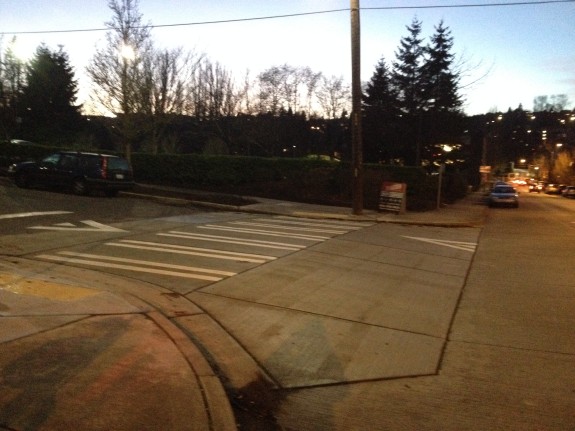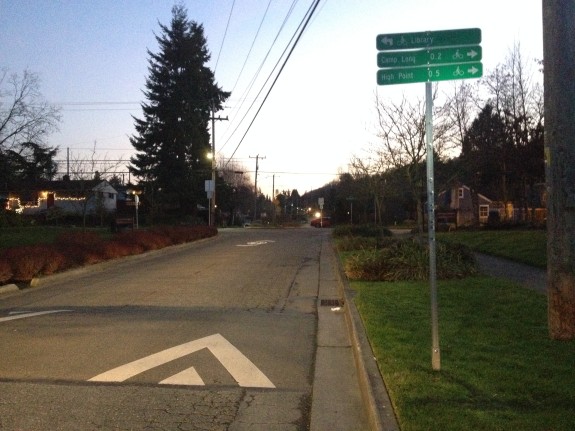 The city has officially completed the first neighborhood greenway in West Seattle, a 1.5-mile stretch of 26th Ave SW from SW Andover Street to the SW Graham Street stairway leading to the High Point neighborhood.
The city has officially completed the first neighborhood greenway in West Seattle, a 1.5-mile stretch of 26th Ave SW from SW Andover Street to the SW Graham Street stairway leading to the High Point neighborhood.
The stretch is the first route in what neighbors hope will be a network of low-stress bike routes connecting homes to the area’s many parks and neighborhood destinations as well as the lower West Seattle Bridge and the hub of trail connections there. The project was supported by West Seattle Greenways and the North Delridge Neighborhood Council.
The 26th Ave SW neighborhood greenway mostly includes elements we have seen on other similar projects, such as speed humps, wayfinding signs and a 20 MPH speed limit. Many elements have been in place for a while, but the city only recently announced its opening.
But one element did stand out: A raised crosswalk at the intersection with SW Andover St:

Raised crosswalks are cool because they send this not-so-subtle message to people driving (and biking) that they are entering a space that belongs first and foremost to people walking. Where crossing the street in far too many places in the city can feel like a stressful rush to get out of the cars’ way, a raised crosswalk is like a red carpet. People driving have to drive up to the sidewalk’s level to cross.
While raised crosswalks are not new to Seattle, this is the first time I’m aware the city has installed one as part of a neighborhood greenway.
 More work is scheduled this year to widen the tiny sidewalk on the east side of Delridge Way between SW Andover Street and the trail hub under the West Seattle Bridge, a long-overdue project that will dramatically improve the connection between the Delridge neighborhood and the Alki Trail, Duwamish Trail, lower West Seattle Bridge and routes to downtown and beyond.
More work is scheduled this year to widen the tiny sidewalk on the east side of Delridge Way between SW Andover Street and the trail hub under the West Seattle Bridge, a long-overdue project that will dramatically improve the connection between the Delridge neighborhood and the Alki Trail, Duwamish Trail, lower West Seattle Bridge and routes to downtown and beyond.








Comments
10 responses to “Delridge neighborhood greenway now officially open”
Raised crosswalks do triple duty — they’re speed humps to slow cars, they emphasize crosswalk right of way, and they raise the crosswalk grade so you’re less likely to get wet feet in a rainy Seattle winter.
Great to see SDOT installing them and marking them correctly — without those warning chevrons, they can be a hazard for cyclists in poor visibility.
Still wish SDOT would use proper sharrows, though — FHWA has again confirmed double-ended sharrows are not an acceptable modification of the MUTCD-approved shared lane use marking, but SDOT keeps using them anyway.
If cities never did anything that wasn’t MUTCD-approved we’d be moving about as fast as the Web would move if developers never did anything that wasn’t W3C-approved.
I agree – raised crosswalks are great for all the reasons you mention. My only complaint with this one is that the raise is much too subtle. I would have preferred it to be raised even more!
Cool! I’m so happy to see SDOT embracing the use of raised crosswalks in greenways. It’s interesting that they decided to use the crosswalk as a speed table, crossing the greenway. I’d like to see their usage considered along greenways as well. That is, at non-arterial crossings without curb ramps and arterial crossings in 20mph (ie, school) zones, they could force drivers who are crossing the greenway to slow down.
Generally I agree with Josh about things like this, but I cannot bring myself to care even a little bit about SDOT’s modified sharrows. Sharrows, as defined in the MUTCD, are basically useless window-dressing. They “may” serve one of a handful of positioning or awareness functions, none of which confers special rights to cyclists that they wouldn’t have without the presence of the sharrow. If SDOT wants to make them vaguely useful by turning them into navigational aids (not MUTCD-approved), or to save a little cash by using the bi-directional ones (not MUTCD-approved), I say go for it. What’s the potential downside?
Thanks for the post, Tom. It was great to see this come to completion.
One huge positive that should be emphasized: the crossing at 26th and Genesee it much safer, mainly due to the 20mph limits (with flashing signs) for east/west traffic. With the community center and skate park nearby, neighbors have been voicing concerns about this crossing for years, and it’s great to see the Greenway work finally address that concern.
I was a bit disappointed that there was no traffic diversion built-in to this Greenway. A major complaint from neighbors before this project was commuters speeding down 26th as an alternative to Delridge. That issue is much better now, but a suitably designed traffic diverter somewhere along the route (like those seen in many Portland greenways) would have been a very nice improvement – there is still a lot of cut-through traffic north of Genesee where drivers zip through narrow streets over to Dakota to avoid the light at 26th/Delridge. The SDOT representatives on the project told us that due to emergency vehicle access issues, however, such diversions would not be possible.
All-in-all, I’m happy with the project, and it’s clear to me that the neighborhood is now much safer for all road users – pedestrians, cyclists, and drivers included.
Sorry, that should have been “avoid the light at Genesee and Delridge”
Jake,
I can understand the concern by SDOT regarding emergency vehicle access – it is an issue, especially with how large fire engines are in North America. Additionally, then north side of the intersection at 26th and Genesee is tricky from a traffic calming aspect, because of the proliferation of driveways, and their proximity to the intersection. Dakota street is less encumbered, but looks to have some issues as well with access to the Kidney Center.
None the less, there does look to be space for a few treatments that would help reduce the ‘straight shot’ element of those streets – if residents were willing to loose some street parking. Specifically, curb extensions such as Chicanes or Pinchpoints might be possible, and would help. Additionally, a “Gateway” could possibly be implemented at Dakota and Delridge.
All of those elements, taken from NACTO’s Urban Street Design Guide (which SDOT helped write), would help control and reduce speeding, while maintaining oversized vehicle access. Practically, even if the turn radius some of these elements created is too tight for some emergency vehicles, there’s nothing stopping a fire truck or ambulance from popping the curb. Bumpy, perhaps, but workable and practical.
I would love for some of those ideas to be included, but would anticipate push-back from the residents. For example, last year when the large apartment complex was built at Dakota & 26th, as part of the project the developer was planning to bring 26th ave up to city standards by putting in curbs and a gutter on the west side of the right-of-way. Neighbors were concerned about the roadway becoming narrower and fought this until the plan to finish the street was dropped! (no word on whether these were the same neighbors who complained for years about speeding cut-through traffic, which the improvement would have greatly ameliorated, but I digress…)
The Greenway is great for those in the know, but I wish there were more wayfinding signs from nearby arterials, such as Delridge. A pass-through rider would never know about the greenway 2 blocks away.